Listening to the Language of Trees: What the Forest Teaches About Belonging
Step into a forest and pause. Even before words arrive, the body softens. The air feels thicker, calmer, almost charged. There is a reason for this. Trees are not silent. They communicate with one another, with the soil, and even with us, if we learn how to listen.
Science affirms what wisdom traditions have carried for generations: forests speak in a language of connection. Underground, tree roots and fungal networks form vast systems of exchange. Nutrients, warnings, and signals travel through this “wood-wide web,” allowing forests to function as living communities. Aboveground, tree canopies share light, shelter, and the rhythm of seasons. Together, these gestures tell a story of belonging.
What Trees Teach Us About Connection
The language of trees is subtle but profound. When one tree is attacked by pests, it releases chemicals to warn its neighbors, who respond with defenses of their own. When a seedling struggles in poor soil, nearby trees can send nutrients through root systems to help it grow. In ancient forests, “mother trees” nurture younger ones by extending support across decades.
These patterns are reminders for us. Belonging is not built on independence, but on relationship. Like trees, we thrive through connection, generosity, and reciprocity. To forget this is to sever ourselves from the very networks that sustain life.
Science Meets Spirit
Researchers continue to uncover the mechanics of tree communication (Scientific American). Yet long before scientific studies, Indigenous traditions recognized trees as kin, teachers, and companions. In Celtic lore, each tree carried spiritual significance, guiding human life through its qualities. In many Indigenous North American traditions, trees are honored as relatives — beings who embody patience, rootedness, and wisdom.
Both science and spirit converge on the same truth: trees are alive in ways that invite us into deeper relationship. To walk among them is to be reminded of our own place in the web of life.
Practices of Listening
Listening to the language of trees does not require a doctorate in forestry. It requires attention.
- Slow walk: Move quietly through a grove, noticing the shapes, sounds, and scents around you.
- Tree sit: Rest your back against a tree and breathe slowly, letting your senses open.
- Observation journal: Choose one tree near your home and visit it daily for a week, recording changes you notice.
- Gratitude offering: Place water or compost at the base of a tree, acknowledging its presence as kin.
These rituals may seem simple, but they build relationship. The more we attend, the more the forest reveals.
Collective Belonging
In times when human society feels fragmented, the forest reminds us of another way: belonging as interdependence. We are part of a vast web, always exchanging, always connected. To tend trees is to tend this belonging, and to allow them to tend us in return.
The Sanctuary grows from this same recognition — that soil, soul, and community are interwoven. When we walk the path of reciprocity, we remember what the forest whispers: you belong, you are held, you are part of the whole.
Closing Invitation
This week, spend time with a tree near your home or along your daily path. Sit, lean, or walk slowly beneath its branches. Notice how your body responds. Journal with the prompt: When I listen to trees, I hear…
Carry those words with you as a reminder that language is more than human, and that the forest is always speaking.




